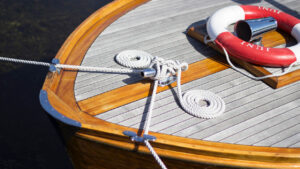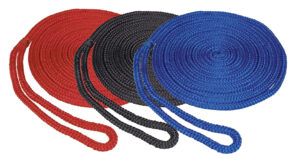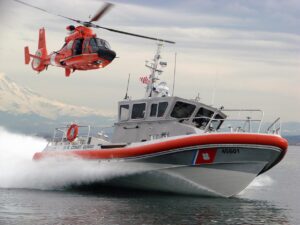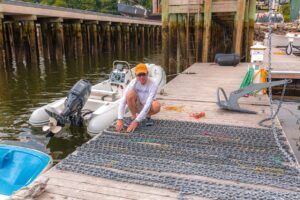WITH SO MANY choices available in dock lines, it’s easy to twist yourself into a knot deciding which is the best type to use aboard your boat. Let’s untangle some of this confusion and sort out different materials and composition to understand what works best for different situations.

The first choice to make is in the line material. The most commonly used material for dock lines is nylon, and for good reason. Nylon provides good shock absorbing properties, with the ability to stretch up to 15% of its length. This elasticity reduces stress from sudden loads on cleats and deck hardware. It has excellent resistance to ultraviolet degradation from sun exposure. Nylon also stands up to fuels and chemicals that are commonly used on or around boats.
Dacron polyester is another popular material in nautical lines, but they are best used aboard sailboats as the running rigging of sheets and halyards. Polyester makes a poor dock line material, in that it has very little ability to stretch for shock attenuation. Polypropylene is an inexpensive line often used for water sport towing, such as waterskiing and rafts, but it is a poor choice for dock line material, due to relatively low breaking strength and rapid degradation from ultraviolet light.
Composition or strand structure is the next important item to consider. The three most common constructions are three-strand, double-braid and multi-plait.
Three-Strand Rope
The three-strand rope construction has been in use for thousands of years. Archeologists have discovered pieces of three-strand rope in Egypt, dating back to the time of the pyramids, made exactly as they are made today. It is available in nylon, polyester and polypropylene. Nylon three-strand is a good economical choice for dock lines.
Advantages:
• Easy to handle wet or dry
• Easy to splice and knot
• Excellent elasticity
• Retains a high percentage of strength if one strand is damaged
• Good chafe resistance
• Most economical
Disadvantages:
• Becomes stiff over time
• Coils loosely, taking up more room in storage spaces
• Offers less strength than double-braid or multi-plait for the same size
Double-Braid Rope
The next most popular composition is double-braid, which consists of an outer jacket that is braided around an inner core. It offers good elongation
and elasticity, which lessens strains and stresses on dock lines and hardware. Like three-strand, double-braid also is available in nylon and polyester, with nylon being the better choice.

Advantages:
• More flexible than three-strand
• Offers the most overall strength
• Easier to handle than three-strand
• Coils tighter than three-strand, taking less space in storage
• Available in a range of color combinations to coordinate with boat colors
Disadvantages:
• More difficult to splice than three-strand or multi-plait
• Provides less elasticity than three-strand or multi-plait
• Has less abrasion resistance than three-strand
• The fine fibers in the braided outer jacket snag easily on rough surfaces
• Damage to the outer jacket will impact line strength
• The most expensive
Multi-Plait Braided Line
The third type of line is multi-plait braided line, which uses individually braided strands woven together, provides high strength, but allows the line to be more relaxed. It is usually available in 8-plait and 12-plaits of braiding. Due to its flexible nature and high strength, it is frequently used in 8-plait composition as anchor line but makes an exceptional dock line as well. Although less popular than three-strand or double-braid, it is in many ways the best alternative.

Advantages:
• Similar strength as three-strand for the same diameter
• Easier to splice than double-braid
• Coils the tightest of all types, taking up less storage space
• Less prone to becoming stiff over time
• More elasticity than double-braid
• Good abrasion resistance
• Less expensive than double-braid
Disadvantages:
• More difficult to splice than three-strand
• Has less elasticity than three-strand
• Not as strong as double-braided
• Most absorbent, so heavier to handle when wet
• More expensive than three-strand
Size in Diameter
The length and diameter of your dock lines, are equally important to their performance, as are the material and composition type. Bigger is not always better. If too large of a diameter line is used, it doesn’t provide as much stretch as a thinner line under equal loads.
Length
All boats should carry a minimum of two bow and two stern lines, along with two spring lines. It is recommended that bow and stern lines range between 1/2 and 2/3 of your boat length. Spring lines should range between the length of the boat to 1 1/3 of your boat length. Remember, you can always deal with some excess line, but too short of a line is worthless.
Chafe Guards
Even the most durable lines can be damaged from repeatedly rubbing against rough surfaces on the pier or boat. Chafe guards are typically made of highly durable woven nylon and add an extra layer of protection to the dock lines, safeguarding the lines from abrasion damage. Lines can also damage the finish of your boat when they move against gelcoat or painted surfaces. You can place soft chafe guards over the dock lines at these points to prevent harm to the boat’s finish.
Home Versus Travel Lines
If you frequently depart from and return to a “home” marina, you may want to consider fixing lines permanently to the pier or pilings of your slip. By doing so with a spliced eye available for the boat, you always know the lines will be the correct length when securing the boat in the slip. It makes for easy departing and returning with no lines to coil and stow.
The biggest risk to look out for in fixing permanent lines is the tendency to ignore the condition of the lines where they are wrapped to cleats and pilings. Be sure to have appropriate chafe guards in place and inspect them often. In selecting travel lines, look for durability, because you never know the condition of the cleats and pilings you will encounter. It is also helpful to select a line type that coils and stows easily.
Dock lines require care and maintenance like everything aboard the boat. Inspect them regularly for wear and damage. Lines exposed to salt water can degrade more quickly from the abrasive nature of dried salt embedded in the line fibers. Never use solvents or harsh chemicals to clean lines. Lines are best cleaned by soaking in a large tub with mild detergents and rinsing thoroughly with fresh water.
A boat tied with clean lines secured and coiled properly, not only provides peace of mind in protecting the boat, but shows you care for and have pride in your boat and its condition.





